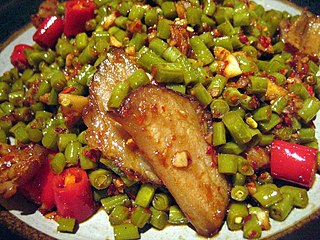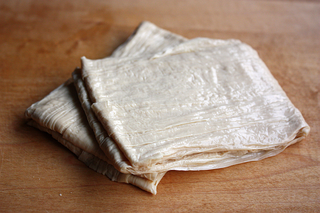Related Research Articles

Hunan cuisine, also known as Xiang cuisine, consists of the cuisines of the Xiang River region, Dongting Lake and western Hunan Province in China. It is one of the Eight Great Traditions of Chinese cuisine and is well known for its hot and spicy flavours, fresh aroma and deep colours. Despite this, only about 20% of the cuisine uses capsicum to produce a strong spicy taste. Common cooking techniques include stewing, frying, pot-roasting, braising and smoking. Due to the high agricultural output of the region, ingredients for Hunan dishes are many and varied.

Zhajiangmian, commonly translated as "noodles served with fried bean sauce", is a dish of Chinese origin consisting of thick wheat noodles topped with zhajiang, a fermented soybean-based sauce. Variations may include toppings of fresh or pickled vegetables, beans, meat, tofu, or egg. In the Western press, it is occasionally dubbed "Beijing bolognaise" due to its superficial similarity and ubiquitous nature.

Stinky tofu is a Chinese form of fermented tofu that has a strong odor. It is usually sold at night markets or roadside stands as a snack, or in lunch bars as a side dish, rather than in restaurants. Traditionally the dish is fermented in a brine with vegetables and meat, sometimes for months. Modern factory-produced stinky tofu is marinated in brine for one or two days to add odor. Generally speaking, stinky tofu is mainly made of tofu. After fermentation of edible mold, tofu can produce a large number of B vitamins, a variety of minerals and trace elements. The flavor of stinky tofu is bitter.

Methyl yellow, or C.I. 11020, is an organic compound with the formula C6H5N2C6H4N(CH3)2. It is an azo dye derived from dimethylaniline. It is a yellow solid. According to X-ray crystallography, the C14N3 core of the molecule is planar.

Douhua is a Chinese sweet or savoury snack made with silken tofu. It is also referred to as doufuhua, tofu pudding, soybean pudding or, particularly in northern China, tofu brains.

Douchi is a type of fermented and salted black soybean most popular in the cuisine of China, where they are most widely used for making black bean sauce dishes.

Tofu skin, yuba, beancurd skin, beancurd sheet, or beancurd robes is a food item made from soybeans. During the boiling of soy milk, in an open shallow pan, a film or skin composed primarily of a soy protein-lipid complex forms on the liquid surface. The films are collected and dried into yellowish sheets known as tofu skin. Since tofu skin is not produced using a coagulant, it is not technically a proper tofu; however, it does have a similar texture and flavor to some tofu products.

Fermented tofu is a Chinese condiment consisting of a form of processed, preserved tofu used in East Asian cuisine. The ingredients typically are soybeans, salt, rice wine and sesame oil or vinegar. In mainland China the product is often freshly distributed. In overseas Chinese communities living in Southeast Asia, commercially packaged versions are often sold in jars containing blocks 2- to 4-cm square by 1 to 2 cm thick soaked in brine with select flavorings.

Tahô is a Philippine snack food made of fresh soft/silken tofu, arnibal, and sago pearl. This staple comfort food is a signature sweet and tahô peddlers can be found all over the country.

Dougan is a firm variety of tofu which is popular in Chinese cuisine. It differs from regular tofu in that it is firm whereas tofu is soft. It is made from soybeans with added calcium sulfate, and sometimes flavored with salt, soy sauce, and spices such as cinnamon, star anise, and licorice.
Lufu is a type of fermented bean curd from Yunnan Province in Southwest China. It is colored reddish yellow, it has a soft texture, and it has a savory flavor. It is used as a condiment for kăo ĕrkuāi or made into a sauce for Yunnan-style barbecue or stinky tofu.

Tofu is a food prepared by coagulating soy milk and then pressing the resulting curds into solid white blocks of varying softness: silken, soft, firm, extra firm. Tofu is translated as bean curd in English. Tofu originated in China and has been consumed in the country for over 2,000 years. Tofu is a traditional component of many East Asian and Southeast Asian cuisines; in modern Western cooking, it is often used as a meat substitute.
Food safety incidents in Taiwan have received international media scrutiny.

Pig blood curd, also known as "blood tofu" or "blood pudding", is a popular delicacy originating from China. It is commonly served with carbohydrates, such as noodles or congee.

Buddha's delight, often transliterated as Luóhàn zhāi, lo han jai, or lo hon jai, is a vegetarian dish well known in Chinese and Buddhist cuisine. It is sometimes also called Luóhàn cài.

Barista Coffee is a Taiwanese coffeehouse chain. Founded in March 1997, Barista Coffee is the first Taiwanese chain coffee shops that is characterised by deep roasted coffee beans.
References
- 1 2 Chen, Liting. "全台都淪陷! 食藥署公布36毒豆乾" [Taiwan is Fully Affected! The Food and Drug Administration Releases List of 36 Toxic Tofu Products]. UDN (in Chinese). Archived from the original on 18 December 2014.
- ↑ "全台都淪陷! 食藥署公布36毒豆乾" [Taiwan is Fully Affected! The Food and Drug Administration Releases List of 36 Toxic Tofu Products]. cw.com.tw (in Chinese). 2019-12-07. Archived from the original on 7 December 2019. Retrieved 2024-12-15.
- 1 2 "三個把關漏洞 讓台灣食安頻NG" [Three Oversight Loopholes Leading to Frequent Food Safety Failures in Taiwan] (in Chinese). 2019-09-24. Archived from the original on 24 September 2019. Retrieved 2024-12-15.
- ↑ "毒豆乾案起訴求重刑" [Prosecution Seeks Harsh Penalties in Poisonous Tofu Case] (in Chinese). 2014-12-31. Archived from the original on 31 December 2014. Retrieved 2024-12-15.
- ↑ Peng, Jingyou (2016-03-04). "政院食品雲升級啟動 強化食安" [Executive Yuan Launches Upgraded Food Cloud to Enhance Food Safety] (in Chinese). Archived from the original on 4 March 2016. Retrieved 2024-12-15.
- ↑ Lin, Jin (2019-12-07). "又見毒豆乾!德昌「五香豆乾」被驗出含二甲基黃" [Toxic Tofu Strikes Again! Dechang's 'Five-Spice Tofu' Found to Contain Dimethyl Yellow]. 自由時報電子報 (in Chinese). Archived from the original on 7 December 2019. Retrieved 2024-12-15.
- ↑ Daxi Tofu Contaminated with Toxins "民生報", 维基百科,自由的百科全书 (in Chinese), 2024-11-24, retrieved 2024-12-15
- ↑ Tofu Contamination Scandal Causes Decline in Daxi Tourism Business "大成報", 维基百科,自由的百科全书 (in Chinese), 2024-07-28, retrieved 2024-12-15
- ↑ "台黑心豆干 驚爆使用油漆染料" [Taiwan's Tainted Tofu Scandal: Paint Dye Found in Production]. The Epoch Times (in Chinese). 2019-06-06. Archived from the original on 6 June 2019. Retrieved 2024-12-15.
- 1 2 Wang, Shengli (2013-06-07). "油漆染料製黑心豆干 已賣了7年" [Blackhearted Tofu Made with Paint Dye Sold for 7 Years] (in Chinese). Archived from the original on 17 December 2014.
- ↑ Hong, Suqing (2014-12-17). "皂黃、己二烯酸鉀小檔案" [Profiles of Auramine O and Potassium Sorbate]. 自由時報電子報 (in Chinese). Archived from the original on 17 December 2014. Retrieved 2024-12-15.
- ↑ Chen, Shufen (2016-03-04). "港驗問題豆乾 德昌:將追上游" [Hong Kong Detects Problematic Dried Tofu, Dechang: Will Investigate Upstream] (in Chinese). Archived from the original on 4 March 2016. Retrieved 2024-12-15.
- ↑ Xiu, Ruiying. "德昌豆干 檢驗證實使用工業染料" [Dechang Dried Tofu Tested Positive for Industrial Dye]. BREAKINGNEWS (in Chinese). Archived from the original on 16 December 2014.
- ↑ "德昌豆乾待檢驗 業者預防性下架" [Dechang Dried Tofu Pending Test Results, Manufacturer Takes Preventive Measures by Pulling Products from Shelves]. CNA (in Chinese). 2016-03-05. Archived from the original on 5 March 2016. Retrieved 2024-12-15.
- ↑ "德昌豆乾染禁劑 乳化劑出包" [Dechang Dried Tofu Contaminated with Banned Chemicals, Emulsifier Issues]. CNA (in Chinese). 2016-03-04. Archived from the original on 4 March 2016. Retrieved 2024-12-15.
- ↑ Xie, Wenhua (2018-12-14). "德昌、黃大目等4家豆乾驗出恐致癌二甲基黃" [Dechang, Huang Damu, and 4 Other Tofu Brands Tested Positive for Cancer-Causing Dimethyl Yellow]. LTN (in Chinese). Archived from the original on 14 December 2018. Retrieved 2024-12-15.
- ↑ Li, Yiting. "驗出工業染料…黑心豆乾 全台幾淪陷" [Industrial Dye Detected... Contaminated Tofu Brands Spread Across Taiwan]. UDN (in Chinese). Archived from the original on 6 January 2015.
- ↑ Chen, Shufen (2014-12-17). "台中追問題豆乾 多家業者中標" [Taichung Investigates Problematic Tofu, Multiple Businesses Affected]. CNA (in Chinese). Archived from the original on 2014-12-17. Retrieved 2014-12-17.
{{cite web}}: CS1 maint: unfit URL (link) - ↑ Cai, Minghua (2016-03-04). "毒豆乾風暴擴大 受波及業者增為23家" [Toxic Tofu Scandal Expands, Affected Businesses Increase to 23]. 蘋果日報 (in Chinese). Archived from the original on 4 March 2016. Retrieved 2024-12-15.
- 1 2 Zhan, Zhiyuan (2016-04-07). "追致癌油皮 維力炸醬麵、大乾麵中了" [Tracking Carcinogenic Oil Skin: Wei Li Fried Noodles and Large Noodles Affected]. 蘋果日報 (in Chinese). Archived from the original on 7 April 2016. Retrieved 2024-12-15.
- ↑ Bo, Yang (2014-12-18). "疑染二甲基黃 維力盼政府加強把關" [Suspected Contamination with Dimethyl Yellow – Wei Li Hopes the Government Will Strengthen Oversight]. CNA (in Chinese). Archived from the original on 18 December 2014. Retrieved 2024-12-15.
- ↑ "違法使用二甲基黃事件之查核進度說明" [Progress Report on the Investigation of the Illegal Use of Dimethyl Yellow]. FDA (in Chinese). 2019-12-07. Archived from the original on 7 December 2019. Retrieved 2024-12-15.
- ↑ "扯!黑心豆乾爆新毒物 首見添二乙基黃 二乙基黃用於汽柴油塑膠 吃多恐致癌 前所未見!食品摻二乙基黃 疑全球首例" [Scandal! New Toxic Substance Found in Black-hearted Tofu – Dimethyl Yellow Now Added with Diethyl Yellow. Diethyl Yellow, Used in Diesel and Plastics, May Cause Cancer if Consumed in Large Quantities. This Could Be the First Case of Diethyl Yellow in Food Globally!]. TTV (in Chinese). 2014-12-25. Archived from the original on 25 December 2014. Retrieved 2024-12-15.
- ↑ "貪便宜 毒劑染豆乾 用量僅需1%" [Cheap Thrills: Toxic Dye Contaminates Tofu, Only 1% Needed for Effect]. appledaily (in Chinese). 2014-12-17. Archived from the original on 17 December 2014. Retrieved 2024-12-15.
- 1 2 "臺北市衛生局持續監督違法添加二甲基黃相關產品" [Taipei City Health Bureau Continues to Monitor Products Contaminated with Illegal Addition of Dimethyl Yellow]. health.gov.tw (in Chinese). 2015-01-01. Archived from the original on 1 January 2015. Retrieved 2024-12-15.
- ↑ Li, Yuechun (2016-03-24). "再爆毒豆干!新東陽香辣豆干又驗出「二甲基黃」" [Another Toxic Tofu Incident! Shin Dong Yang Spicy Tofu Found to Contain "Dimethyl Yellow"]. The News Lens 關鍵評論網 (in Chinese). Archived from the original on 24 March 2016. Retrieved 2024-12-15.
- ↑ "臺北市衛生局持續監督違法添加二甲基黃相關產品". 2015-01-01. Archived from the original on 1 January 2015. Retrieved 2024-12-15.
- ↑ Zheng, Mianmian (2014-12-26). "食物添加奶油黃 賣相較好卻易罹肝癌" [Food Additive Butter Yellow: Better Appearance but Increases Risk of Liver Cancer] (in Chinese). Archived from the original on 26 December 2014. Retrieved 2024-12-15.
- ↑ 吳, 哲豪 (2015-07-30). "毒豆干案 芊鑫負責人父子遭判刑 | 社會 | 重點新聞". 中央社 CNA (in Chinese). Archived from the original on 2016-03-05. Retrieved 2016-03-05.
- ↑ 王, 揚宇 (2017-06-19). "毒豆干案 芊鑫負責人父子判刑定讞 | 社會". 中央社 CNA (in Chinese). Archived from the original on 2019-05-25. Retrieved 2019-05-25.